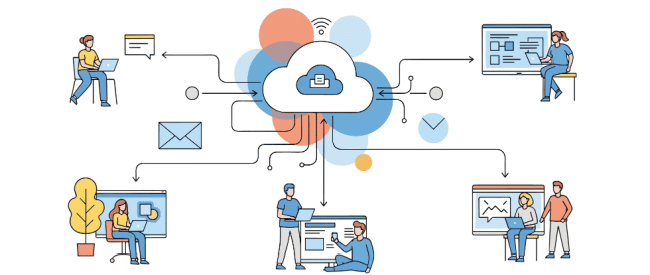.
The surge of disruptive events in recent years, from natural disasters and cyberattacks to the global pandemic and other crises, has had a devastating impact on many businesses. Even companies that responded effectively under pressure, such as managing workarounds during widespread shutdowns in the early months of the COVID-19 pandemic, need to regularly assess their state of preparedness in the event of other emergencies.
Companies can be particularly vulnerable when it comes to maintaining cash flow and revenues. The imperative to keep money coming in demands a keen focus on customer communications, especially billing, and payment operations.
There’s a high cost for lack of readiness: Among the 96% of business leaders that suffered a business disruption in the past two years, 76% said it had a medium to high impact on their operations, according to PwC’s 2023 Global Crisis and Resilience Survey.
To reduce organizational risk from these types of incidents, companies must develop, execute and update business continuity and disaster recovery plans, especially for key functions such as billing and collections.
Scoping the risk
Companies need to create plans tailored to the specific needs of the organization and address threats such as:
- Natural disasters. Hurricanes, earthquakes, floods, and wildfires can threaten health and safety, lead to loss of life, cause significant damage to physical infrastructure and disrupt operations.
- Power outages. Weather is the most common cause of power outages, but animals, vehicle crashes and power equipment failures can all lead to a brownout, surge or extended outage.
- Security breaches. Ransomware, phishing attacks, and data breaches can compromise sensitive data and immobilize essential systems. Keypoint Intelligence notes that as companies further integrate artificial intelligence (AI) and Internet of Things (IoT) devices, the complexity of managing cybersecurity risks is increasing.
- System failures. Hardware and software malfunctions can lead to service outages and data loss. Legacy hardware, as well as modern networks and infrastructure, face this risk.
- Human error. Mistakes and negligence can result in costly errors and delays. In January 2023, airline departures were suspended when a worker damaged a database file by mistakenly deleting files. The incident resulted in flight cancellations nationwide, as pilots could not access a system that provides critical flight information.
The cost of business interruptions
While it’s difficult to quantify the exact financial impact of business interruptions on specific industries, studies have shown that the cost of downtime can be substantial. A cyberattack on a major healthcare payment processing company in early 2024 has led to $1.521 billion in direct response costs and $2.457 billion in total cyberattack impacts as of September 30, according to company financial reports.
While the payment processing company is expected to survive, 40 percent of companies do not reopen after a disaster, and another 25 percent fail within one year, according to the Federal Emergency Management Agency.
A business interruption can have severe consequences for billing and collections departments. Some of the impacts include:
- Revenue loss. Disruptions in billing and payment processing can lead to delayed or missed payments, resulting in sizable corporate revenue loss.
- Customer dissatisfaction. Delayed billing cycles, payment processing issues, and interrupted service availability lead to poor customer experience, eroding customer trust and loyalty.
- Regulatory compliance exposure. Failure to adhere to regulatory deadlines for billing and collections, industry-specific regulations and data privacy standards can result in hefty fines and penalties.
- Operational disruptions. Interruptions in vital systems and processes can hinder the ability to generate accurate invoices, track payments, and manage accounts receivable.
- Increased costs. Recovering from a disruption can incur hefty expenses, exacerbated by employing expensive on-the-fly remediation efforts.
Continuity plan essentials
Organizations that address potential threats can minimize these vulnerabilities and safeguard their financial health. By incorporating essential strategies, businesses can lessen the impact of disruptions and ensure the continuity of their billing and collections operations.
Key considerations when developing a comprehensive plan include:
1. Business impact analysis.
Evaluate the likely impact of various disruptions on your business, including financial losses, customer impact, and regulatory compliance.
2. Critical function identification.
Determine the essential functions within the billing and collections department and prioritize them for recovery.
3. Data backup and recovery.
Working with IT, implement thorough data backup and recovery procedures to protect critical data, including customer information, billing records, and financial data.
4. Redundancy and failover.
Establish redundant systems, such as backup servers and network connections, to ensure business continuity and minimize downtime.
5. Security measures.
Protect sensitive data with advanced security measures, including encryption, firewalls, and intrusion detection systems.
6. Remote work capabilities.
Equip employees with the necessary tools and technology to work remotely, enabling them to continue operations during disruptions.
7. Incident response plan.
Develop a comprehensive incident response plan to address various emergencies and guide the organization’s response.
8. Review and testing.
Regularly test business continuity plans to identify weaknesses and refine strategies.
Nordis’ robust approach to resilience
As a leader in CCM software and digital and print and mail outsourcing services, we recognize our critical role in maintaining timely billing and prompt payments to support our clients’ business sustainability. We have put in place rigorous programs to ensure our business continuity and address disaster prevention and recovery.
Here are some of the key elements for keeping our business running so you can keep your business running.
Cloud technology. Our Expresso® customer communications management system pioneered the use of cloud solutions versus server-based software. Expresso’s cloud-based omnichannel communication platform provides reliability, scalability, and business continuity capabilities, enabling clients to work from any location and manage their digital and paper communications seamlessly. This flexibility is crucial during times of crisis or a challenging business environment, allowing clients to easily scale operations up or down to quickly adapt to changing market conditions and customer demands.
____________________________________
Download our white paper:
Gain Control of Your Omnichannel Collections Communications
____________________________________
Operational redundancy. Nordis strategically located its print and mail production facilities in geographically diverse regions 2,000 miles apart to mitigate risks associated with localized disruptions. This redundancy ensures that if one facility is affected by a business interruption or a regional disaster impacts USPS mailing services, the other print and mail production facility can seamlessly take over operations.
Our Coral Springs, Florida headquarters and production facility is built to withstand CAT 5 hurricanes. Our redundant operations in Florida and Las Vegas are equipped with state-of-the-art digital production technology such as high-speed continuous inkjet printers, high-speed inserters, meter and vision equipment for quality assurance and redundant power supplies.
Enhanced security and data protection. Companies can lower the risk of sharing customer information with multiple vendors and the access, storage and transmission of data with Expresso’s single omnichannel CCM platform. Nordis is committed to robust security measures, including data encryption, access controls, and regular SOC2 Type II security audits.
Because our company handles sensitive documents and personal information, Nordis also complies with industry regulations and data privacy standards such as HIPAA and SOC 2 Type II.
Expertise in partnership. Companies benefit from our round-the-clock monitoring and maintenance of critical systems. We regularly test our business continuity plans, identify potential vulnerabilities, refine response strategies and train our team members on the latest procedures and protocols.
The nature of our business is supporting the business of others. Services are available consistently and without interruption. Through strengthening their own business continuity strategies and leveraging Nordis’ expertise and resources, companies can minimize the impact of disruption, protect their bottom line and build a more resilient organization capable of weathering future storms.
Learn more about how Nordis can help you with business continuity planning. Contact us today.







